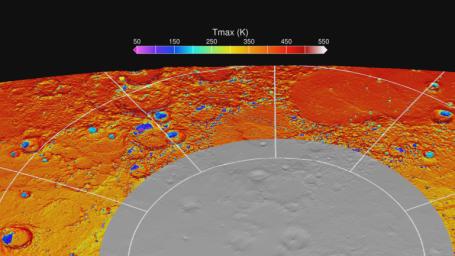Maximum Surface Temperature near the North Pole
Caption:
Map of the maximum surface temperature reached over a two-year period over the
north polar region
of Mercury. This detailed thermal map of Mercury, and others that display additional thermal parameters, are the first to have been calculated from measurements of Mercury's topography by the MESSENGER MLA instrument. Mercury displays the most extreme range of surface temperatures of any body in the Solar System. Regions that receive direct sunlight at the equator reach maximum temperatures of 700 K (800° F), whereas regions in permanent shadow in high-latitude craters can drop below 50 K (-370° F). In this view from above Mercury's north pole, there are numerous craters with poleward-facing slopes on which the annual maximum temperature is less than 100 K (-280° F). At these temperatures, water ice is thermally stable over billion-year timescales.
Instrument:
Mercury Laser Altimeter (MLA)
Background Info:
The MESSENGER spacecraft is the first ever to orbit the planet Mercury, and the spacecraft's
seven scientific instruments and radio science investigation
are unraveling the history and evolution of the Solar System's innermost planet. Visit the
Why Mercury?
section of this website to learn more about the key science questions that the MESSENGER mission is addressing. During the one-year primary mission, MDIS acquired 88,746 images and extensive other data sets. MESSENGER is now in a year-long extended mission, during which plans call for the acquisition of more than 80,000 additional images to support MESSENGER's science goals.
For information regarding the use of images, see the MESSENGER
image use policy
.
Cataloging Keywords:
| Name |
Value |
Additional Values |
| Target |
Mercury |
|
| System |
|
|
| Target Type |
Planet |
|
| Mission |
MESSENGER |
|
| Instrument Host |
MESSENGER |
|
| Host Type |
Orbiter |
|
| Instrument |
Mercury Laser Altimeter (MLA) |
|
| Detector |
|
|
| Extra Keywords |
Color, Crater, Map, Radio, Shadow, Thermal, Water |
| Acquisition Date |
|
| Release Date |
2012-11-30 |
| Date in Caption |
|
|
| Image Credit |
NASA/Johns Hopkins University Applied Physics Laboratory/Carnegie Institution of Washington |
| Source |
photojournal.jpl.nasa.gov/catalog/PIA16525 |
| Identifier |
PIA16525 |

 Planetary Data System
Planetary Data System
